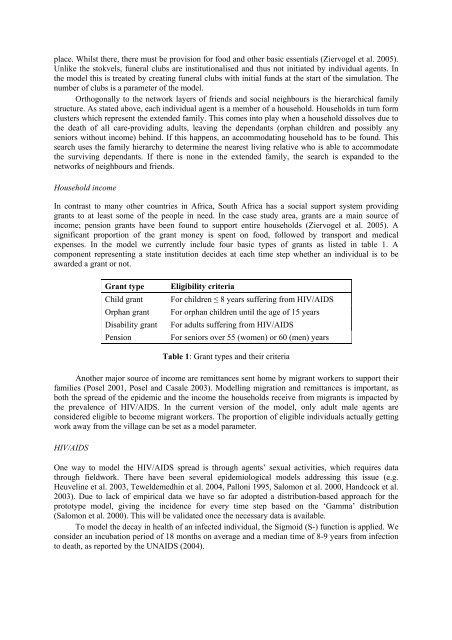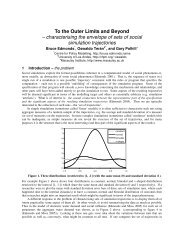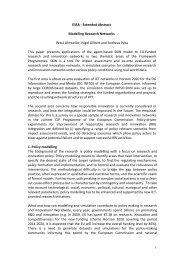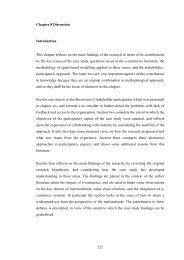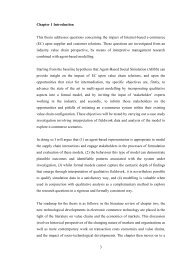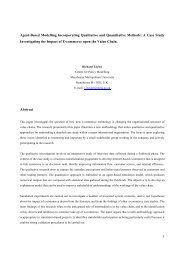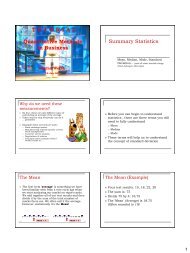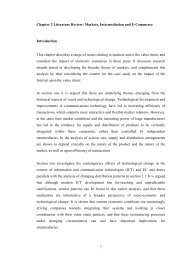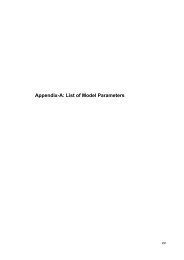Modelling the Socio-Economic Impact of HIV/AIDS in South Africa
Modelling the Socio-Economic Impact of HIV/AIDS in South Africa
Modelling the Socio-Economic Impact of HIV/AIDS in South Africa
You also want an ePaper? Increase the reach of your titles
YUMPU automatically turns print PDFs into web optimized ePapers that Google loves.
place. Whilst <strong>the</strong>re, <strong>the</strong>re must be provision for food and o<strong>the</strong>r basic essentials (Ziervogel et al. 2005).<br />
Unlike <strong>the</strong> stokvels, funeral clubs are <strong>in</strong>stitutionalised and thus not <strong>in</strong>itiated by <strong>in</strong>dividual agents. In<br />
<strong>the</strong> model this is treated by creat<strong>in</strong>g funeral clubs with <strong>in</strong>itial funds at <strong>the</strong> start <strong>of</strong> <strong>the</strong> simulation. The<br />
number <strong>of</strong> clubs is a parameter <strong>of</strong> <strong>the</strong> model.<br />
Orthogonally to <strong>the</strong> network layers <strong>of</strong> friends and social neighbours is <strong>the</strong> hierarchical family<br />
structure. As stated above, each <strong>in</strong>dividual agent is a member <strong>of</strong> a household. Households <strong>in</strong> turn form<br />
clusters which represent <strong>the</strong> extended family. This comes <strong>in</strong>to play when a household dissolves due to<br />
<strong>the</strong> death <strong>of</strong> all care-provid<strong>in</strong>g adults, leav<strong>in</strong>g <strong>the</strong> dependants (orphan children and possibly any<br />
seniors without <strong>in</strong>come) beh<strong>in</strong>d. If this happens, an accommodat<strong>in</strong>g household has to be found. This<br />
search uses <strong>the</strong> family hierarchy to determ<strong>in</strong>e <strong>the</strong> nearest liv<strong>in</strong>g relative who is able to accommodate<br />
<strong>the</strong> surviv<strong>in</strong>g dependants. If <strong>the</strong>re is none <strong>in</strong> <strong>the</strong> extended family, <strong>the</strong> search is expanded to <strong>the</strong><br />
networks <strong>of</strong> neighbours and friends.<br />
Household <strong>in</strong>come<br />
In contrast to many o<strong>the</strong>r countries <strong>in</strong> <strong>Africa</strong>, <strong>South</strong> <strong>Africa</strong> has a social support system provid<strong>in</strong>g<br />
grants to at least some <strong>of</strong> <strong>the</strong> people <strong>in</strong> need. In <strong>the</strong> case study area, grants are a ma<strong>in</strong> source <strong>of</strong><br />
<strong>in</strong>come; pension grants have been found to support entire households (Ziervogel et al. 2005). A<br />
significant proportion <strong>of</strong> <strong>the</strong> grant money is spent on food, followed by transport and medical<br />
expenses. In <strong>the</strong> model we currently <strong>in</strong>clude four basic types <strong>of</strong> grants as listed <strong>in</strong> table 1. A<br />
component represent<strong>in</strong>g a state <strong>in</strong>stitution decides at each time step whe<strong>the</strong>r an <strong>in</strong>dividual is to be<br />
awarded a grant or not.<br />
Grant type<br />
Child grant<br />
Orphan grant<br />
Disability grant<br />
Pension<br />
Eligibility criteria<br />
For children ≤ 8 years suffer<strong>in</strong>g from <strong>HIV</strong>/<strong>AIDS</strong><br />
For orphan children until <strong>the</strong> age <strong>of</strong> 15 years<br />
For adults suffer<strong>in</strong>g from <strong>HIV</strong>/<strong>AIDS</strong><br />
For seniors over 55 (women) or 60 (men) years<br />
Table 1: Grant types and <strong>the</strong>ir criteria<br />
Ano<strong>the</strong>r major source <strong>of</strong> <strong>in</strong>come are remittances sent home by migrant workers to support <strong>the</strong>ir<br />
families (Posel 2001, Posel and Casale 2003). <strong>Modell<strong>in</strong>g</strong> migration and remittances is important, as<br />
both <strong>the</strong> spread <strong>of</strong> <strong>the</strong> epidemic and <strong>the</strong> <strong>in</strong>come <strong>the</strong> households receive from migrants is impacted by<br />
<strong>the</strong> prevalence <strong>of</strong> <strong>HIV</strong>/<strong>AIDS</strong>. In <strong>the</strong> current version <strong>of</strong> <strong>the</strong> model, only adult male agents are<br />
considered eligible to become migrant workers. The proportion <strong>of</strong> eligible <strong>in</strong>dividuals actually gett<strong>in</strong>g<br />
work away from <strong>the</strong> village can be set as a model parameter.<br />
<strong>HIV</strong>/<strong>AIDS</strong><br />
One way to model <strong>the</strong> <strong>HIV</strong>/<strong>AIDS</strong> spread is through agents’ sexual activities, which requires data<br />
through fieldwork. There have been several epidemiological models address<strong>in</strong>g this issue (e.g.<br />
Heuvel<strong>in</strong>e et al. 2003, Teweldemedh<strong>in</strong> et al. 2004, Palloni 1995, Salomon et al. 2000, Handcock et al.<br />
2003). Due to lack <strong>of</strong> empirical data we have so far adopted a distribution-based approach for <strong>the</strong><br />
prototype model, giv<strong>in</strong>g <strong>the</strong> <strong>in</strong>cidence for every time step based on <strong>the</strong> ‘Gamma’ distribution<br />
(Salomon et al. 2000). This will be validated once <strong>the</strong> necessary data is available.<br />
To model <strong>the</strong> decay <strong>in</strong> health <strong>of</strong> an <strong>in</strong>fected <strong>in</strong>dividual, <strong>the</strong> Sigmoid (S-) function is applied. We<br />
consider an <strong>in</strong>cubation period <strong>of</strong> 18 months on average and a median time <strong>of</strong> 8-9 years from <strong>in</strong>fection<br />
to death, as reported by <strong>the</strong> UN<strong>AIDS</strong> (2004).


